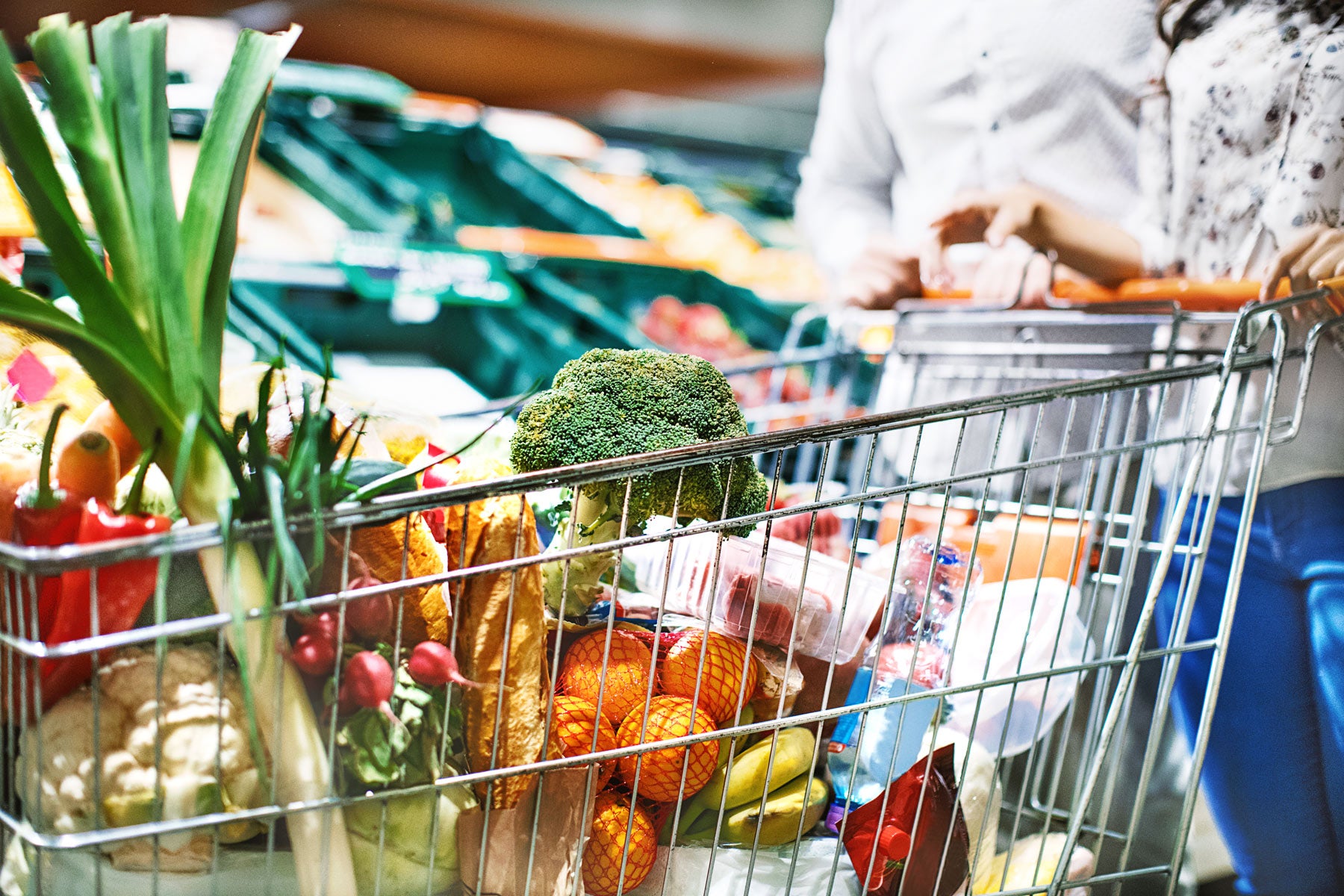
Plant-based or plant-forward eating patterns focus on eating mostly foods derived from plants. This can include fruits, vegetables, nuts, seeds, oils, whole grains, legumes and beans. Eating plant-based does not mean that you need to completely avoid all animal products. Instead, it means you proportionately choose more foods from plant-based sources, all while minimizing the consumption of processed and animal-based products.
What are the potential benefits of a plant-based diet?
- Decreases risk of cardiovascular disease
- Improves blood sugar
- Reduces inflammation
- Possible weight loss
Utica Park Clinic Wellness Point offers classes about plant-based diets. Those can be found here.
Try by starting with one meal every day or dedicating one day every week to these meals. Choose to eat a plant-based lunch every day or implement “meatless Monday.” Over time as you become comfortable with this new way of eating, you can progress to a fully plant-based diet. Make sure you are substituting meats for nutrient-dense alternatives such as beans, legumes, vegetables, fruits or whole grains for this change to have its maximum health benefits.
Include whole grains for breakfast.
- Start your day with oatmeal, quinoa, buckwheat or barley and then add some toppings like nuts, seeds or fresh fruit.
Eat a lot of vegetables.
- Fill half of your plate with vegetables that include a variety of colors at lunch and dinner, such as tomatoes, leafy greens or carrots. If you want a snack, try enjoying vegetables with hummus, salsa or guacamole.
Change the way you think about meat.
- Have smaller amounts and decrease gradually over time. To start, use meat as a garnish instead of a centerpiece.
Choose good fats.
- Fats in olive oil, olives, nuts and nut butters, seeds and avocados are particularly healthy options.
Cook a vegetarian meal at least one night a week.
- Build these meals around beans, whole grains and vegetables. Over time, you may go from one night per week to several.
Go for greens.
- Try a variety of green leafy vegetables like kale, collards, Swiss chard, spinach and other greens each day. Steam, grill, braise or stir-fry to preserve the flavors and nutrients.
Build a meal around a salad.
- Fill a bowl with salad greens such as romaine or bibb lettuce, spinach or red leafy greens. Then try adding an assortment of other vegetables along with some fresh herbs, beans, peas or tofu.
Eat fruit for dessert.
- If you are looking to satisfy your craving for a sweet bite after a meal, try a refreshing slice of watermelon, a crisp apple or even a ripe, juicy peach.
| Fruits | Berries, citrus fruits, pears, peaches, pineapple, bananas, etc. |
| Vegetables | Kale, spinach, tomatoes, broccoli, cauliflower, carrots, asparagus, peppers, etc. |
| Whole Grains | Brown rice, rolled oats, farro, quinoa, brown rice pasta, barley, etc. |
| Healthy Fats | Avocados, olive oil, coconut oil, unsweetened coconut, etc. |
| Legumes | Peas, chickpeas, lentils, peanuts, black beans, etc. |
| Nuts | Almonds, cashews, macadamia nuts, pumpkin seeds, sunflower seeds, natural peanut butter, tahini, etc. |
| Unsweetened Plant-Based Milks | Coconut milk, almond milk, cashew milk, etc. |
| Spices/Herbs/Seasonings | Basil, rosemary, turmeric, curry, black pepper, salt, etc. |
| Condiments | Salsa, mustard, nutritional yeast, soy sauce, vinegar, lemon juice, etc. |
| Plant-Based Proteins | Tofu, tempeh, seitan, beans, lentils and legumes. |
| Beverages | Coffee, tea, sparkling water, etc. |
Breakfast
- Oats with fruit
- Breakfast taco
- Whole wheat or corn tortillas filled with sauteed onions and peppers, black beans and salsa.
- Whole wheat toast with peanut butter, topped with sliced strawberries.
Lunch
- Greek Salad
- Chopped mixed greens with fresh tomato, Kalamata olives, fresh parsley, extra virgin olive oil and balsamic vinegar.
- Homemade Pizza
- Veggie pizza topped with vegan cheese, tomatoes, broccoli, onions, peppers and mushrooms.
- Soup
- Vegetable soup with whole wheat crackers.
Dinner
- Grilled vegetable kabobs with grilled tofu, quinoa and spinach salad.
- Whole wheat pasta tossed with pesto sauce, steamed asparagus and peas
- Stir fry made with tempeh and vegetables served over brown rice.
- Vegetarian chili
Plant Based Queso
Ingredients
- 1 cup Yukon Gold potato, peeled and diced
- ¼ cup carrot, peeled and diced
- 1/3 cup onion, diced
- ¾ up water reserved from boiled veggies
- ½ cup raw cashews, soaked in room temp water overnight or very hot water for at least 30 mins
- ¼ cup coconut milk
- 2 tablespoons nutritional yeast
- 1 tablespoon lemon juice
- 1 teaspoon salt
- ¼ teaspoon garlic powder
- ¼ teaspoon chili powder
- 1 teaspoon cumin
- 1 pinch cayenne pepper (optional)
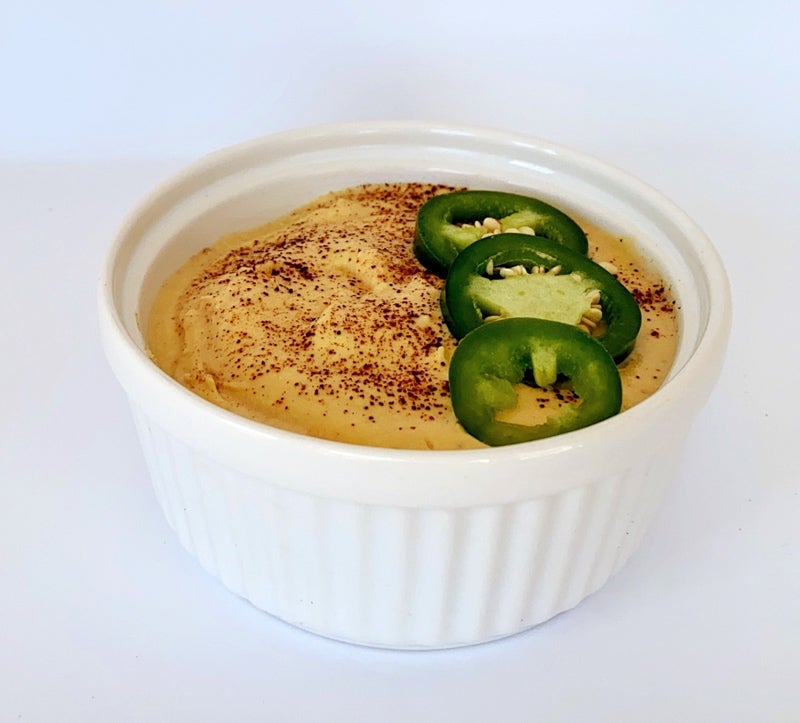
Directions
- Bring several cups of water to boil in a medium pot. Add potatoes, carrots and onions to boiling water and cook for about 10 minutes, or until they are soft.
- When veggies are soft enough to blend, use a slotted spoon to remove them from cooking water and place them in your blender. Add ¾ cup of the cooking water to your blender along with the remaining ingredients and blend until smooth.
- Remove from blender and then serve.
Creamy Overnight Protein Oats with Berries
Creamy, delicious, easy to make and packed with fiber and protein, these oats make a perfect easy breakfast. Adding a scoop of plant-based protein powder makes these oats extra creamy and super filling. Chia seeds add fiber and omega-3 fatty acids and strawberries deliver a big dose of vitamin C.
Ingredients
- 1 scoop vanilla flavored plant-based protein powder
- ½ cup old fashioned oats, dry
- 1 tablespoon chia seeds
- 1 cup almond milk, unsweetened
- ½ cup fresh strawberries
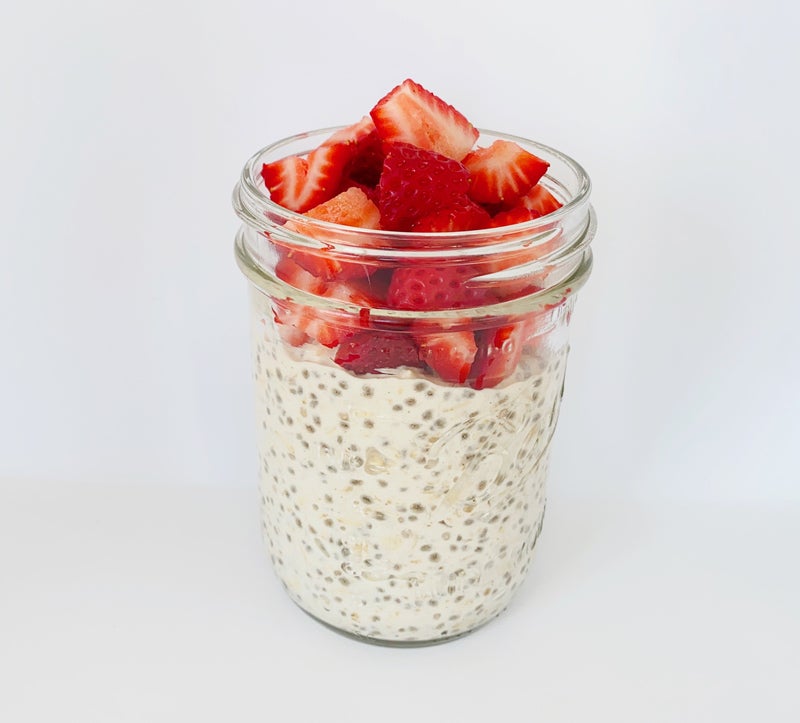
Directions
- Combine protein powder with almond milk and mix until smooth.
- Stir in oat and chia seeds. The mixture will be a bit soggy at this point, but the oats and chia seeds will absorb more as the mixture sits.
- Top with strawberries.
- Place in the refrigerator overnight for breakfast the next day. Can be made up to five days in advance.
*Note: To make without protein powder, reduce the amount of almond milk to 2/3 cup
Lentil Bolognese
Ingredients
- 1/2 cup yellow onion, diced
- 3 garlic cloves, minced
- 1 cup of mushrooms, diced
- 1 teaspoon oregano
- ½ teaspoon red pepper flakes (optional)
- 1 tablespoon olive oil
- One 28 oz. can of red crushed tomatoes
- 1 cup lentils (green or brown. Avoid red lentil for this recipe as they are too soft)
- 1 cup water
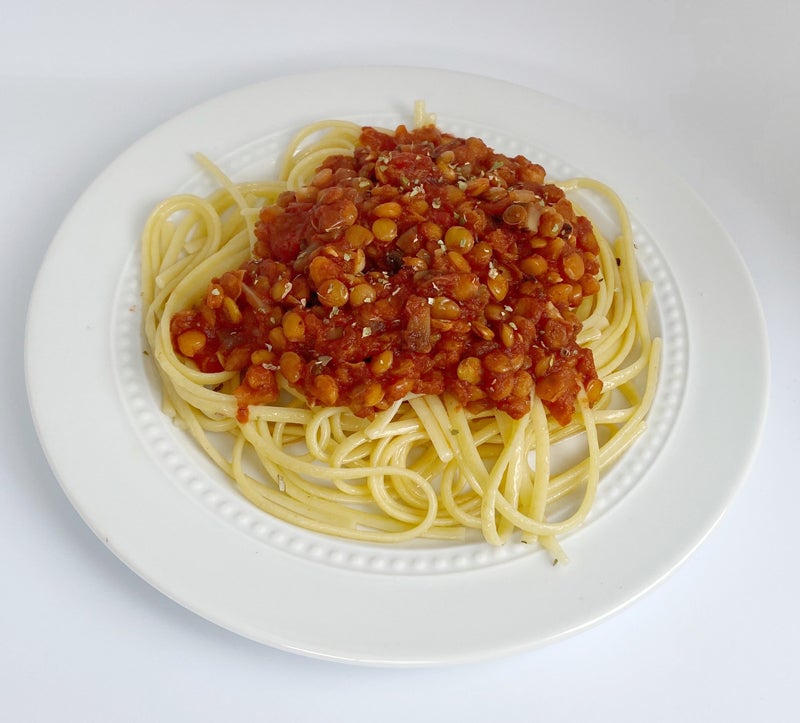
Directions
- Heat a large skillet over medium heat. Add olive oil and then onion, mushrooms and garlic. Sautee for about 5 minutes, onions should be fragrant and translucent.
- Add the red crushed tomatoes, water, lentils, oregano and red pepper flakes. Cover and simmer for 20-25 minutes, or until lentils are fully cooked.
- Serve over pasta.
Leftovers from this sauce are good for five days or do great frozen and reheated.
Black Bean Tacos
Ingredients
- 1 tablespoon olive oil
- ½ medium onion, chopped
- 1 jalapeno, chopped (optional)
- 1 teaspoon ground cumin
- ½ teaspoon salt
- 1 teaspoon dried coriander
- 2 cloves garlic, minced
- One 15 oz can black beans, drained
- 1 tablespoon tomato paste
- ¼ cup water
- 8 corn tortillas
- Optional toppings: cilantro, green onion, lime juice, avocado or guacamole
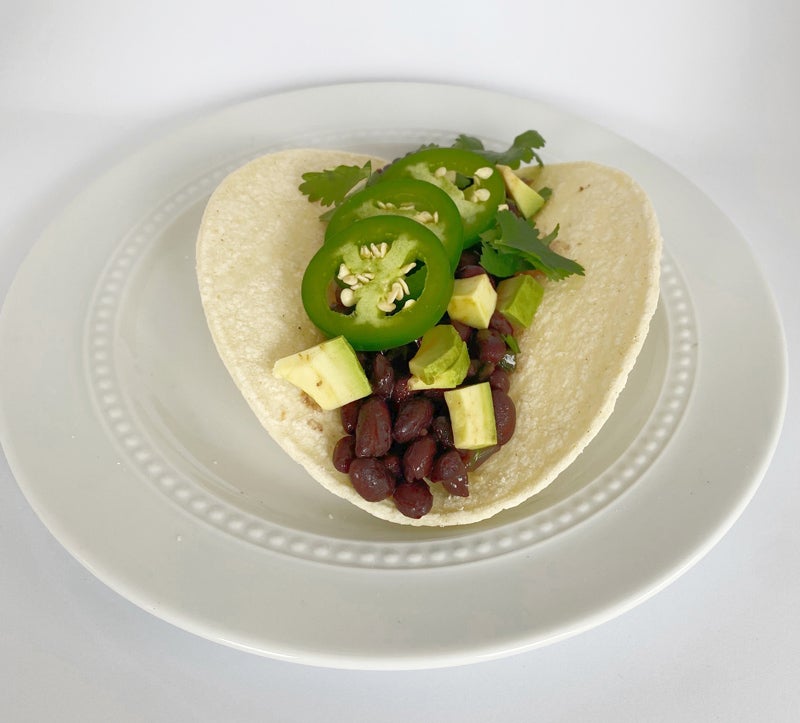
Directions
- Heat olive oil in a medium skillet over medium to high heat.
- Add onions, jalapeno, cumin, coriander and salt. Stir and sautee for 3-5 minutes until onions are soft.
- Add garlic and sautee one additional minute.
- Add black beans and tomato paste. Stir and combine for 3-5 minutes toasting the tomato paste slightly.
- Add the ¼ cup of water and stir to combine and thin the tomato paste.
- Remove from heat and serve in warm corn tortillas.
Plant Based Chili
The secret ingredient in this chili may surprise you! Cocoa powder adds a lovely depth of savory flavor to this plant-based chili. You just have to try it!
Ingredients
- 1 tablespoon olive oil
- 1 medium onion, chopped
- 1 cup carrots, finely diced
- 1 jalapeno, diced (optional)
- 4 cloves of garlic, minced
- 3 cups of vegetable broth
- 1 cup of uncooked lentils
- One 6 oz can tomato paste
- One 15 oz can kidney beans, rinsed and drained
- One 15 oz can black beans, rinsed and drained
- 1 tablespoon cocoa powder
- ½ teaspoon salt
- 1 tablespoon chili power
- ¼ teaspoon cayenne pepper (optional)
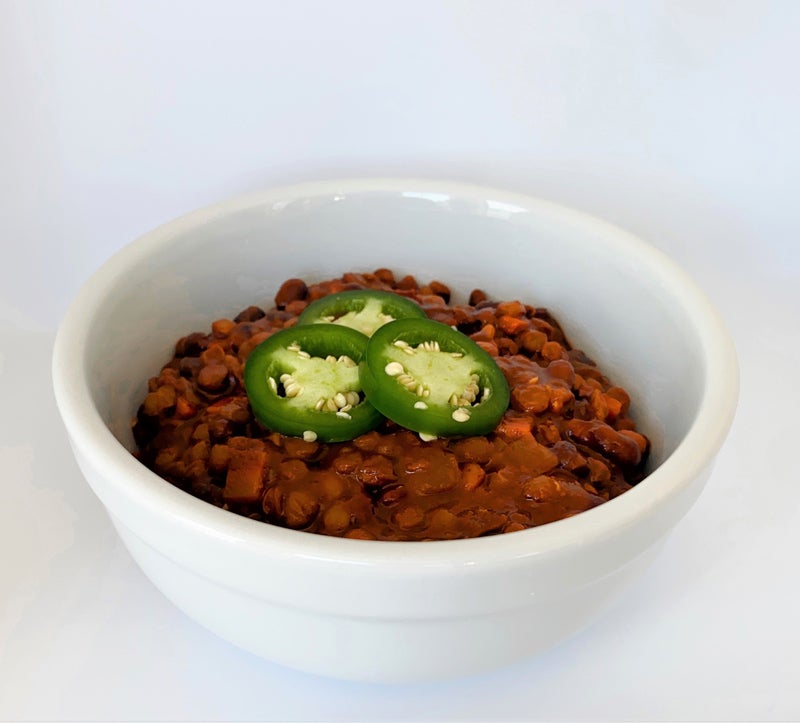
Instructions
- Heat olive oil in a large pot over medium heat. Add onion and carrots and cook for 3-5 minutes
- Add garlic and jalapeno, then sautee for an additional 2 minutes.
- Add tomato paste and stir 3-5 minutes, browning the paste until it is brick colored.
- Add remaining ingredients: lentils, broth, kidney beans, back beans, cocoa powder, salt, chili powder and cayenne.
- Stir and bring to a boil. Reduce heat to a simmer and cover. Cook 25-30 minutes.
- Remove from heat and serve.
Diabetes
Q: What are the different types of diabetes?
A: Type 1 diabetes, which used to be called, juvenile diabetes, affects about 5% of people with diabetes. Type 1 diabetes is an autoimmune disease which results in the pancreas no longer being able to make any insulin on its own. People with type 1 diabetes will have to take insulin shots to control their blood sugar.
Type 2 diabetes is the most common type of diabetes. People with type 2 diabetes still make insulin in their pancreas, in fact they may make more insulin than is typical. Type 2 diabetes in characterized by insulin resistance. This means that while your body is still making plenty of insulin, it can’t use it properly. People with type 2 diabetes may also need to take insulin injections to control their blood sugar.
Q: What is insulin?
A: Each person with diabetes can be a little different and goals will change weather you are fasting or have recently eaten. Here are some general guidelines:
- Fasting (before eating or drinking in the morning): under 130
- Two hours after the start of a meal: under 180
Q: What is an A1c?
A: Hemoglobin A1c, sometimes called A1c, is a measure of your blood sugar over several months. The results you get from an A1c test look different than the blood sugar reading you see at home on your glucose meter, instead of measuring exactly how much sugar is in your blood at this moment, an A1c test measures how much sugar (glucose) has attached to red blood cells in your body. This result is given in a percentage. A healthy A1c for most people with diabetes is under 7.0%
Q: How can I control my blood sugar?
A: While there are factors that influence you blood sugar that are outside of your control such as age and genetics, there are plenty of things that you do that make a very big impact on your blood sugar. The four M’s of diabetes are the basis of a healthy life with diabetes. The four M’s of diabetes are:
- Monitoring (testing your blood sugar regularly)
- Medication (taking your medications as prescribed)
- Meal Planning (eating healthy, balanced meals)
- Motion (being physically active)
A diabetes care and education specialist can help you learn more about managing your diabetes. Contact us today for education opportunities.
Plant-Based Diet
Q: Why should I consider a plant-based diet?
A: Plant-based diets have been linked with many health benefits such as lower risk for heart disease, type 2 diabetes and cancer. Following a plant-based diet may also help you lose weight as most plant-based foods are lower in calories.
Q: What does the diet consist of?
A: Plant-based eating patterns focus on eating mostly plant foods. This can include fruits and vegetables, as well as nuts, seeds, oils, whole grains, legumes and beans. Eating plant-based does not mean that you need to completely avoid all animal products, rather that you are proportionately choosing more foods from plant-based sources.
Q: Will I get enough protein eating a plant-based diet?
A: It’s very possible to meet your protein needs on a plant-based diet. Most plant-based foods contain at least a small amount of protein. Legumes such as beans, peas and lentils contain roughly the same amount of protein in ½ cup as you would find in 1 ounce of meat. Including a protein rich food at each meal such as legumes, beans, nuts, soy or tofu is a great strategy to get plenty of protein.
Q: I’m interested in following a plant-based diet, how do I get started?
A: Join us for an introductory class all about getting started with plant-based eating!
For more information or to schedule an appointment, please call 918-579-0545 or visit our Wellness Point page here.
Utica Park Clinic Wellness Point
8803 S. 101st E. Ave., suite 165
Tulsa, OK 74133
